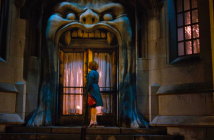1994
Hungarian filmmaker, Béla Tarr, represents everything that is right with contemporary cinema and through the international film festival circuit he has garnered critical acclaim as well as developed a strong reputation based on his very unique sense of directorial style. Despite Tarr’s small scale successes, as Peter Hames points out, his films will forever run into funding problems and stand a zero chance of obtaining wide theatrical releases or airing on television (Hames, 2001). These are the results of Tarr’s more recent work that characteristically contain numerous long takes and deliberately slow pacing, which has forced many viewers to deem his films unwatchable. But, for those who have an open mind and are patient enough will discover in Tarr’s work, his ability to not only tell a story, but “to get us closer to people, to help understand everyday life” (Hames, 2001).
In 1985, after Béla Tarr and his partner and editor Agnes Hranitzky read Laszlo Kraszahorkai’s novel Sátántangó, they immediately wanted to adapt it to film. However, the strict political climate in Hungary at the time, combined with the novel’s content shelved the project until the early 1990’s. After the issues surrounding the film subsided, production finally got underway in 1991 and lasted on and off for three more years. Through the perspectives of several different characters, the story of Sátántangó examines the downfall of a small Hungarian village of cattle farmers as the period of communism in Middle Europe comes to a close. Every member of the collapsed community believes that their share from the village’s group cattle sale represents their only escape and because of this they frequently attempt to cheat other members of the community out of their rightful income. Even when tragedy strikes the village, other members are quick to take advantage of the tragic circumstances (Heilman, 2001). The structure of the film, like the novel, resembles the structure of the tango. Specifically, the film is broken up into twelve different chapters that are not told in a chronological order, but rather six chapters forward andsix chapters back.
As one of the more experimental filmmakers, Tarr and his production crew did write a screenplay for Sátántangó, but it was mostly for funding purposes only, as a large portion of dialogue for the film was improvised on set. Even all the decisions in regards to editing process were all done during the shooting of the film and not in post-production, which is usually the case. Synonymous with Tarr’s more recent work, Sátántangó is largely composed of numerous long takes, several of them lasting up to eleven minutes in length, which is the maximum a single reel of film can capture. In a 2000 interview, Tarr jokingly stated that the 300 metres or eleven minute time limit a Kodak holds acts as a “kind of censorship” to his work (Schlosser, 2000). These notoriously long takes combined with Tarr’s mesmerizing slow pace and immense depth of field produce some surprisingly beautiful sequences and generate a special kind of tension that is not apparent in films consisting of several shorter takes.
In the past, Béla Tarr has commented that “most contemporary cinema provides no time or space to understand people” (Hames, 2001). This is indeed the case, as studios continue to force their filmmakers to shorten their films with lengthy runtimes in an attempt to increase the number of daily theatrical viewings and release films with more commercial appeal, while at the same time leaving filmmakers with true artistic quality without funding. Most of the films these days are so preoccupied with displaying the biggest action sequence or the most gruesome death scene that they forget about the most important element in cinema, the human element. After viewing Sátántangó, I didn’t feel as if I knew any of the characters on a personal level, but by the end of the film there is a sort of familiarity there in the characters that is mostly nonexistent in contemporary cinema. With the film’s exceptionally long length of seven and a half hours, Tarr allows the audience to understand the tendencies and motivations of each individual character, which in the end gives a more complete and fulfilling account of the events that unfold. Overall, Sátántangó brilliantly examines the hardships of everyday life in Middle Europe and perfectly captures the effects of the post-Communist era. While watching Sátántangó, you soon begin to realize that it is a film like nothing you have ever seen before and by the end you realize that it is one of the important achievements in the history of cinema.
[notification type=”star”]99/100 - While watching Sátántangó, you soon begin to realize that it is a film like nothing you have ever seen before and by the end you realize that it is one of the important achievements in the history of cinema.[/notification]
Sources.
Daly, Fergus & Le Cain, Maximilian. “Waiting For the Prince - a interview with Béla Tarr”. Senses of Cinema. January 2001.
Hames, Peter. “The Melancholy of Resistance: The Films of Béla Tarr”. Kinoeye. September 3, 2001.
Heilman, Jeremy. “Satantango”. Moviemartyr.com. October 2001.
Schosser, Eric. “Interview with Béla Tarr”. Brigh Lights Film Journal. 2000.




